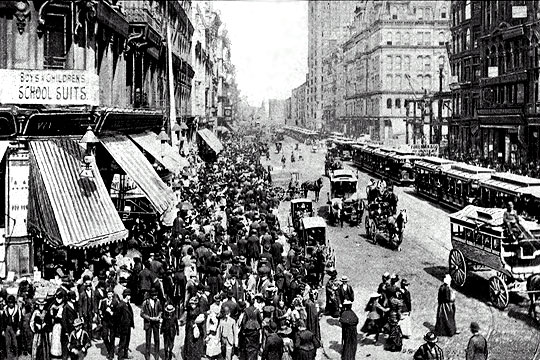 |
| The Grand Ballroom at the Everleigh Club |
The Everleigh Club was
the epitome of glamour. Guests flocked to see “the room of 1,000 mirrors, with
a floor made entirely of reflective glass.” They came to see “the ballroom,
with its towering water fountain, parquet floor arranged in intricate mosaic
patterns, and ceiling that dripped crystal chandeliers,” and dined with “a
feast of fried oysters, Welsh rarebit, deviled crabs, lobster, and caviar.” And
after the guests were entertained by song and dance in the twelve lavish reception parlors, they
retire to one of “the thirty boudoirs, each with a mirrored ceiling and marble
inlaid brass bed, a private bathroom with a tub laced in gold detailing,
imported oil paintings, and hidden buttons that rang for champagne.”[1]
Only the rich and famous were permitted to enjoy the club’s decadent
atmosphere, food, and ultimately sex. Yes, sex because the Everleigh club was not what you just imagined to be the Ritz-Carlton, but instead, a high class
brothel.
It’s hard to imagine
a place so marvelous can also be a house of sin. That is why the Everleigh club
is a perfect symbol of the Gilded Age, a period spanning approximately the last
three decades of the 19th century. Mark Twain coined the term to
describe a period in American history that was lavish on the surface but in
reality, dishonorable with many social problems.[2]
Cities like Chicago experienced an era of rapid economic growth as American
wages became much higher than in Europe. As a result, “the stream of
immigration that flowed in the 1890s became a deluge…more arrived everyday from
Italy and Germany, France and China, Russia and Greece.”[3]
The influx of immigrants caused rapid industrialization and urbanization in
American cities like Chicago.
Although cities
during the Gilded Age like Chicago was in some aspects prosperous because of
industrialization, the era was also defined by poverty as poor immigrants
poured in. “Many girls were desperately poor, burdened with supporting parents,
siblings, and children. They had been juvenile delinquents and tossed out of
the home, and the $35 per week that one made as a whore-even in a low class
resort-far exceeded the $6 she could earn in a factory.”[4]
Therefore, prostitution can be linked to immigration, industrialization and
urbanization of the Gilded Age. As cities like Chicago became more urban with
increased population, the more that poverty came into play and thus,
prostitution became more prevalent as many women struggle to make a living.
This is clear when Reverend John P. Brushingham said, “Chicago, great in
population, great in commerce, and great in sin.”[5]
 |
| Chicago in the 1890 |
The Everleigh sisters
used the Gilded Age’s population, commerce, and sin to capitalize. After the
sisters gave careful consideration and did a lot of research, they decided to
open their new brother in Chicago as they saw the city’s growing potential. The
sisters then made an effective business plan that centered around the formula,
“the more difficult to gain entry to an establishment, the greater the number
of people who vie to do so.”[6]
Therefore, a great amount of money was spent on decoration and maintaining the
health of the harlots, something their competitors overlooked. This business
plan helped the Everleigh Club flourish as "companies
were welcome to set up corporate and expense accounts at the brothel for their
employees," and "manufacturers were known to spare no expense when
wooing important dealers."[7]
| The Everleigh sisters |
Another factor that helped
the Everleigh Club prosper is from the support of influential figures. The
sisters weaved a web of important relationships with clients such as Michael
‘Hinky Dink’ Kenna and ‘Bathhouse John’ Coughlin, who were the “true leaders”
of the Levee district. After being elected to the Chicago City Council, the two
men controlled “both the wealthiest and most depraved of Chicago.”[8]
The Everleigh sisters wisely established a good
relationship with the two men who “received a portion of every dollar generated
in the red light district” when they agreed to protect the businesses in the
district. This demonstrates the political landscape of the Gilded Age as
somewhat corrupt.
Part one of Sin in the Second
City sets the scene of the Gilded Age, marked by deceiving appearances of
America during that time.
Christina Aguilera, Lil' Kim, Mya, Pink - Lady Marmalade
This video and song reminds me of the Everleigh Club
[1] Karen Abbot, Sin in the Second City: Madams,
Ministers, Playboys and the Battle for America's Soul (New York:
Random House, 2007), 68-70.
[2] S. Mintz, and S. McNeal. Digital History, "Gilded Age." Accessed March 24, 2014. http://www.digitalhistory.uh.edu/era.cfm?eraid=9&smtid=1.
[4] Abbot, Sin in the Second City, 19-20.
[5] Abbot, Sin in the Second City, 65.
[6] Abbot, Sin in the Second City, 18.
[7] Abbot, Sin in the Second City, 73.
[8] Abbot, Sin in the Second City, 58.
No comments:
Post a Comment